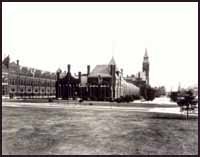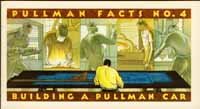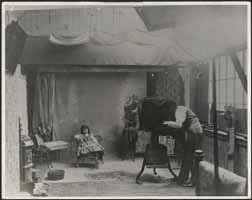The Factory Complex
You are at Home -> The Pullman Company -> The Factory ComplexThe Factory Complex
The factory buildings, Administration Building, and Clock Tower were unusual in that the architectural design and treatment defied the common practice of having drab, uninteresting building for industrial use. The Pullman buildings were given an architectural identity and set in a park-like setting. In front of the Administration Building was the beautifully landscaped Lake Vista -- an artificial lake created to serve as a cooling reservoir for the Corliss Steam Engine. The factory buildings provided unusually good working conditions for employees. The factory buildings were well lighted and ventilated. The walls were painted in light colors to create a cheerful atmosphere. They were not to be compared to the sweatshops of the time. The cars were constructed in assembly line fashion, a remarkable method for the time. The Administration Building and Clock Tower formed the central mass of a monumental structure seven hundred feet long. Its architectural design reflects mixed heritage. As both real and symbolic expression of the great economic power, which was the Pullman Company, it was essential the building display a strong sense of formal ordering. At the center rises the clock tower and roof, which was echoed in the shapes of the gabled pavilions which marked the outer end of the long facade. The entire structure is oriented with the most impressive elevation to the west away from the town, which served it, and toward the Illinois Central. The power and majesty of the building was intensified by its mirror image in Lake Vista, the artificial lake that once stood before it. The central pavilion with its clock tower clearly expresses where the center of authority stood. It is hard to imagine what vista was afforded to visitors arriving by train, as most did, when they looked in awe at the grandeur of the factory, the gardens, the hotel and the arcade. The architectural heritage reflected in the Administration Building descends from the formal symmetrical ordering of elements associated with French architecture of the 17th and 18th centuries. The formality is emphasized by the landscape treatment of the area surrounding the building. The costuming style of the building ornamentation descends from romantic naturalistic heritage largely borrowed form England. In an attempt to harmonize the Administration Building with the rest of the town, Beman has been forced to introduce a wide variety of both arched and rectilinear forms into his facade in an attempt to disguise the fact that is so rigidly symmetrical. The arched shapes in both the tower and end pavilion contrasts with the angular statements made by the regularly spaced skylights of the factory wings. The buildings were ventilated with numerous windows and skylights and the interiors were painted light colors to maximize natural light making working condition in the factory complex better than most for the time. This delicate, airy, salubrious construction resulted, ironically, in the early demise of the building's structure. The skylights were framed entirely of wood -- the quality of fine cabinetry, but entirely inappropriate to withstand the elements over the years.THE PULLMAN HISTORY SITE

More Information About the Pullman Company
Products from the Factory
Edison Films of Pullman Travel

From A Romance of the Rail, 1903
Other Pullman-Related Sites
- Historic Pullman Garden Club - An all-volunteer group that are the current stewards of many of the public green spaces in Pullman. (http://www.hpgc.org/
- Historic Pullman Foundation - The HPF is a non-profit organization whose mission is to "facilitate the preservation and restoration of original structures within the Town of Pullman and to promote public awareness of the significance of Pullman as one of the nation's first planned industrial communities, now a designated City of Chicago, State of Illinois and National landmark district." (http://www.pullmanil.org/)
- The National A. Philip Randolph Pullman Porter Museum is a 501(c)3 cultural institution. Its purpose is to honor, preserving present and interpreting the legacy of A. Philip Randolph, Pullman Porters, the Brotherhood of Sleeping Car Porters and the contributions made by African-Americans to America's labor movement. ((http://www.nationalpullmanportermuseum.com/)
- Pullman Civic Organization - The PCO is a strong and vibrant Community Organization that has been in existence since 1960. (http://www.pullmancivic.org/)
- Pullman National Monument - The official page of the Pullman National Park. (https://www.nps.gov/pull/)
- South Suburban Genealogical & Historical Society - SSG&HS holds the Pullman Collection, consisting of personnel records from Pullman Car Works circa 1900-1949. There are approximately 200,000 individuals represented in the collection. (https://ssghs.org/)
- The Industrial Heritage Archives of Chicago's Calumet Region is an online museum of images that commemorates and celebrates the historic industries and workers of the region, made possible by a Library Services and Technology Act grant administered by the Illinois State Library. (http://www.pullman-museum.org/ihaccr/)
- Illinois Digital Archives (IDA) is a repository for the digital collections libraries and cultural institutions in the State of Illinois and the hosting service for the online images on this site. (http://www.idaillinois.org/)













